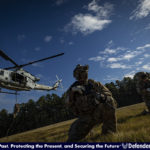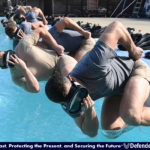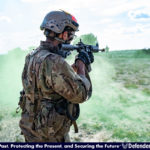JOINT BASE SAN ANTONIO-RANDOLPH, Texas (AFNS) — To better afford enlisted recruits the time and opportunity to find the path of their greatest calling, the Air Force has created a single path of entry into the special warfare recruiting and initial training pipeline. The Special Warfare Operator Enlistment Vectoring program will officially commence in early April with a new Air Force Specialty Code for accessions and the first shipment of special warfare candidates to the service’s basic military training.
“On initial entry into the Air Force, the 9T500 AFSC will be the only path for new Airmen to pursue a career into the Combat Control, Pararescue, Tactical Air Control Party or Special Reconnaissance career fields,” said Lt. Col. Joseph Lopez, Air Education and Training Command headquarters special warfare division chief. “This change allows candidates to make a more informed career decision, prior to being vectored, after months of education, training, development and mentorship, to see what career field might be the best fit for them. The program also enhances the Air Force’s ability to assign Airmen a permanent AFSC in an equitable way across the special warfare community after a thorough “whole-person” evaluation has been conducted on every candidate going through the accessions and initial phase of training.”
~ ~ ~ ~ ~ ~ ~ ~ ~ ~ ~ ~ ~ ~ ~ ~ ~ ~ ~ ~
Stay up to date on U.S. Air Force Security Forces activities around the world with a subscription to Defender Magazine. TRY our 30-DAY FREE TRIAL by Clicking HERE.
~ ~ ~ ~ ~ ~ ~ ~ ~ ~ ~ ~ ~ ~ ~ ~ ~ ~ ~ ~
Every day, special warfare Airmen deploy around the world to project American military power through global access, rescue friendly forces through personnel recovery operations and to destroy the enemy through precision strikes.
The SWOE-V program centers on a “coach-develop-mentor” mindset that begins in the pre-accession phase where recruiting development teams identify potential special warfare operators and begin the process to prepare them for the rigors of the special warfare training pipeline and later, their designated career field.
“The typical special warfare scouting, recruiting and development process for a candidate from pre-accessioning to shipping to BMT takes from four to six months,” said Lt. Col. Heath Kerns, 330th Recruiting Squadron commander which specializes in special warfare and combat support recruiting. “During pre-accessioning with help from our developers, candidates begin a 21-day “Pass the PAST” workout program developed to help them pass the Physical Abilities Stamina Test, while at the same time being educated on special warfare components, missions and specialties and the SWOE vector process.”
Another key element to the SWOE-V program will be the base lining of enlistment standards for recruits.
“Having a standardized baseline of enlistment standards will eliminate confusion amongst potential recruits, as well as opens up a larger pool of candidates during the recruiting process who might be eligible for and interested in a career in special warfare,” Kerns said.
After a potential candidate passes the PAST, a test that represents the minimum physical fitness entrance standards for enlisted special warfare career fields, they compete for selection and receive a developer recommendation before contracting and shipping to BMT at Joint Base San Antonio-Lackland as a SWOE candidate, Kerns said.
During BMT, SWOE candidates will master curriculum that includes the Air Force mission and vision, core values, drill and ceremony, history and priorities, field training and joint warfare like every other trainee, but undergo additional training to prepare them for the Special Warfare Prep Course.
“While assigned to their special warfare BMT flights, candidates conduct additional physical training and continue their education about all things special warfare related including components, missions and specialties and the SWOE vectoring process,” Lopez said.
SWOEs’ BMT performance evaluation data is collected throughout training to be included as part of the vectoring process once trainees enter the Special Warfare Prep course, administered by officials at the Special Warfare Training Wing, also at JBSA-Lackland.
“Along with the performance data from BMT, data from the Special Warfare prep course and a SWOE’s career preference, candidates are vectored to either the Special Tactics and Guardian Angel, or the Tactical Air Control Party, courses of initial entry,” Lopez said.
Selection for a specific special warfare Air Force Specialty Code is heavily based on a candidate’s performance, which drives a competitive model early on, even before shipping to BMT, thus helping shape individual’s drive, determination and strengths, intended to create trust and team cohesion among candidates, Lopez said.
“Nothing is given; Airmen must earn their spot in their chosen career field and fight for it,” Lopez said. “We are evaluating them continuously through pre-accessioning, BMT and the Special Warfare Prep Course, using a whole person concept that includes cognitive, physical skills as well as Airmanship and instructors’ evaluation of teamwork and attitude.”
From this point in the pipeline, SWOE candidates are split into one of two paths: the four-week Special Tactics and Guardian Angel course of initial entry or the TACP initial course of entry.
“After successful completion of the ST/GA initial course of entry, candidates will be assigned into the combat controller, pararescue or special reconnaissance AFSC based on their continued performance during training and their preference,” Lopez said. “After successful completion of that course, candidates continue along their respective AFSC-specific training pipelines.”
Those who enter the TACP course of initial entry and successfully complete it will continue along in the remainder of the TACP training pipeline, Lopez said.
“The SWOE-V really is a big deal as it represents a momentous change for the Air Force special warfare community,” Lopez said. “By removing constraints in the recruiting and accessions process, we are expanding the talent pool while streamlining entry into the service. We also ensure equitable distribution consistent with and proportional to Air Force-established production goals.”
To hear more about the SWOE-V program, listen to “The Air Force Starts Here” podcast featuring Lt. Col. Lopez, AETC’s special warfare division chief, and Lt. Col. Heath Kerns, 330th Recruiting Squadron commander.
By Dan Hawkins, Air Education and Training Command Public Affairs / Published February 21, 2020
Special Warfare Airmen with the New Jersey Air National Guard’s 227th Air Support Operations Squadron fast-rope from a UH-1Y Venom helicopter with Marine Light Attack Helicopter Squadron 773 during training on Joint Base McGuire-Dix-Lakehurst, N.J., Oct. 10, 2019. All recruits wanting to join the Air Force in a special warfare career field will now be vectored into a specific career field during initial skills training under the Special Warfare Operator Enlistment Vectoring program, which is now the single path of entry into the combat control, pararescue, tactical air control party and special reconnaissance career fields. (U.S. Air National Guard photo by Master Sgt. Matt Hecht)
Special Warfare trainees from the 352nd Special Warfare Training Squadron participate in a physical training session at the Triangle Pool on Keesler Air Force Base, Miss., Aug. 9, 2019. With the new Special Warfare Operator Enlistment Vectoring program, there is one path of entry for new recruits to careers in combat control, pararescue, tactical air control party and special reconnaissance. (U.S. Air Force photo by Kemberly Groue)
Tactical Air Control Party, or TACP, Airmen participate in a field training exercise at Joint Base San Antonio-Camp Bullis, Texas, July 11, 2019. All recruits wanting to join the Air Force in a special warfare career field will now be vectored into a specific career field during initial skills training under the Special Warfare Operator Enlistment Vectoring program, which is now the single path of entry into the combat control, pararescue, tactical air control party and special reconnaissance career fields. (U.S. Air Force Photo by Andrew C. Patterson)
Tactical Air Control Party, or TACP, instructors with the 353rd Special Warfare Training Squadron conduct physical training drills with trainees during the TACP apprentice course, Jan. 14, 2020, at Joint Base San Antonio-Medina Annex, Texas. All recruits wanting to join the Air Force in a special warfare career field will now be vectored into the service under the Special Warfare Operator Enlistment Vectoring program, which is now the single path of entry into the combat control, pararescue, tactical air control party and special reconnaissance career fields. (U.S. Air Force photo by Sarayuth Pinthong)




